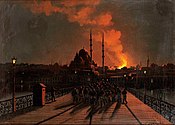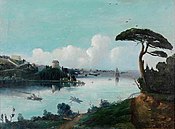|
Garabet Yazmaciyan
Garabet Yazmaciyan (Armenian: Կարապետ Եազմաճեան, 1868–1929) was a prominent Ottoman painter of Armenian descent.[1] StyleYazmacıyan used scenery, color harmonies, and subjects that are of very close resemblance to Mıgırdiç Civanyan (1848–1906). His brushstrokes however are a little more careless and slovenly.[2] In order to be able to make a living from painting like Civanyan, Yazmacıyan had to produce quite quickly. Yazmaciyan also painted for the local Armenian churches. His paintings for the churches are more elaborate, attentive, and refined.[2] One of his works is the double-sided tin shop sign he painted for his own business. On one of the sides, the artist has depicted himself painting. On the rear of the sign one can see a still-life painting. This proclaimed to the potential customers that he was open to conduct business and receive orders of both still-life and portraits.[2] In a way this shop sign is also proof that a painter in late 19th and early 20th century Istanbul was at the same time a tradesman. Similarly this fact suggests that paintings during that period were seen as objects.[2] They were ordered and considered as goods in the Ottoman society and economy, especially among the non-Muslim minorities.[2] The Alluring Woman with Poison in her Mouth is also one of Yazmaciyan's more interesting works. This painting depicts a naked man standing and is wrapped around a half-snake half-human Basilisk that has long claws similar to nails. The Basilisk appears as though it is looking up to god; enraged at being unable to fulfill her desires. There is a stark contrast between the pink body of the man against the blue-black snake like creature with red tinsels. What is open to discussion however is the content of the red-white bohemian cup the man is holding and what it symbolizes.[2] Paintings
References
|
||||||||||
Portal di Ensiklopedia Dunia












